| Release List | Reviews | Price Search | Shop | Newsletter | Forum | DVD Giveaways | Blu-Ray/ HD DVD | Advertise |
| Reviews & Columns |
|
Reviews DVD TV on DVD Blu-ray International DVDs Theatrical Reviews by Studio Video Games Features Collector Series DVDs Easter Egg Database Interviews DVD Talk TV DVD Talk Radio Feature Articles Columns Anime Talk DVD Savant HD Talk Horror DVDs Silent DVD
|
DVD Talk Forum |
|
|
| Resources |
|
DVD Price Search Customer Service #'s RCE Info Links |
|
Columns
|
 |
The Sergio Leone Anthology |
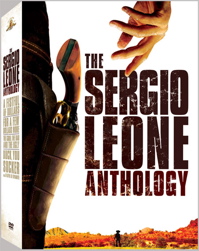
|
The Sergio Leone Anthology MGM (distributed by Fox) Color / 2:35 anamorphic widescreen Street Date June 5, 2007 / 89.98; available separately at 26.98 Original Music Ennio Morricone Directed by Sergio Leone |
MGM Home Entertainment has enjoyed quite a run with the Sergio Leone United Artists westerns, which have always been near the top of their sales charts on VHS, Laserdisc and now DVD. Three of the four titles were released on DVD in 1999 in less-than-adequate encodings; The Good, The Bad and The Ugly was the subject of a 2004 Special Extended Edition. Later that same year MGM Home Entertainment commissioned double-disc special editions for the remaining three titles, and made plans to coordinate their release with a prestigious Sergio Leone exhibition at the Gene Autry Museum in Griffith Park. Finished by Christmas, the three new shows were scheduled for release in the summer of 2005. Then MGM was sold into the hands of a consortium and its home video distribution outsourced to Sony; all MGM releases were disrupted. A year later, MGM pulled its video distribution from Sony and relocated to 20th-Century Fox. Now, 2½ years after completion, the four-title Sergio Leone Anthology has finally arrived.
Region 2 viewers have already seen these special editions in PAL releases from 2005. The extras are mostly the same, but the audio options vary on some of the titles. More importantly, the R2 discs all run at the faster PAL speed of 25fps, which changes the tempo of the music tracks, makes the action look too clipped and pitches un-corrected voices just high enough to make grown men sound like chipmunks. As far as this reviewer is concerned, this set of R1 discs is the first really watchable release.
Beyond a synopsis and a few remarks, I'll limit my discussion of the first two "Dollars" titles to the new editions and refer readers unfamiliar with the films to the older review. As The Good, The Bad and the Ugly is unchanged from its Extended Edition release, it will be discussed even less. The newcomer to R1 DVD Duck You Sucker will receive more attention.

Fistful of Dollars
1964 / 100 min. / Per un pugno di dollari / available separately at 26.98
Starring Clint Eastwood, Marianne Koch, Gian Maria Volontè, Wolfgang Lukschy, Seighardt Rupp, Joe Egger, Aldo Sambrell, Mario Brega
Cinematography Massimo Dallamano
Art Direction Carlo Simi
Film Editor Roberto Cinquini, Alfonso Santacana
Written by A. Bonzzoni, Jaime Comas Gil, Victor Andrés Catena, Sergio Leone
Produced by Arrigo Colombo, Giorgio Papi
Fistful of Dollars (the on-screen title has no "A", despite MGM's ad copy) is an inexpensive movie. If this transfer looks less attractive than the others its partly because it wasn't as carefully photographed, and because of a lack of access to prime transfer elements. The transfer doesn't look bad overall, although one can still perceive a 'pulsing' quality in some scenes, especially shots in Joe's first gundown, the "my mule is upset" scene. Otherwise the enhanced transfer cleans up a great many flaws.
The first three films were originally monaural, although MGM has remixed them all in processed faux-stereo. One of the main complaints about the extended version of GBU is that the original mix had been augmented (many fans said defaced) with extra sound effects, and both dialogue and music were altered. Early suspicions about this new release centered on whether MGM would respect the integrity of the original films by retaining the original mono tracks. Happily, mono tracks are provided for the three new restorations. Fistful of Dollars has a Spanish mono as well.
Informed fans mention scenes present in some foreign versions but never seen in UA's export copy, including a scene of the Baxters sitting at the Rojo's dinner table. All of these films were customized for release in different countries. Some scenes were cut after initial engagements, or were perhaps set aside yet reinstated when local censors cut other scenes. When it's difficult to simply get a useable transfer element from a foreign producer, looking for variant versions is not always possible.
The extras feature actor Clint Eastwood and English Leone authority Sir Christopher Frayling. Frayling's entertaining commentaries and interview featurette (A New Kind of Hero) constitute a compressed history of everything related to the Leone cycle -- American and Italian film history, the story of the Italian film industry and detailed insights into practically every face we see on the screen. In the featurette A Few Weeks in Spain Eastwood tells the story of a serious actor who made good, due in no small part to his professional pride in his work. While other American actors abroad just read the lines, rode the horses and headed back to the nightclubs, Eastwood rewrote his own dialogue, kept his own script notes and then made sure it was recorded correctly in dubbing sessions. "The Man with No Name" thus comes off as the coolest gunslinger in history.
The featurette Tre Voci gathers the memories of producer Alberto Grimaldi, writer Sergio Donati and actor/dubbing director Mickey Knox. Also of interest is Donald Bruce's Location Comparisons that match film scenes with new photography of the same locations today. Some sets are completely gone but others remain intact.
Curious Leone fans will most want to see the Network Prologue that was added to Fistful of Dollars for its first prime-time TV showing in 1977. Thought long lost, the prologue was preserved by fan Howard Fridkin, who recorded it on one of the very first Betamax VCRs. On a separate extra, Not Ready for Prime Time, director Monte Hellman remembers directing the amusingly inept prologue, with actor Harry Dean Stanton and an unconvincing stand-in for Clint Eastwood.
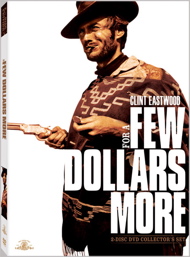
For a Few Dollars More
1965 / 132 min. / Per qualche dollaro in più / available separately at 26.98
Starring Clint Eastwood, Lee Van Cleef, Gian Maria Volontè, Maria Krup, Luigi Pistilli, Klaus Kinski, Joseph Egger, Aldo Sanbrell
Cinematography Massimo Dallamano
Film Editor Adriana Novelli, Giorgio Serralonga, Eugenio Alabiso
Written by Luciano Vincenzoni, Fulvio Morsella, Sergio Leone
Produced by Alberto Grimaldi
More lavishly produced than the first film, For a Few Dollars More is perhaps the best-looking of the four titles on DVD, with brilliant colors and a clean image that belies its half-frame Techniscope origins. The quality can be traced to a complete overhaul of the movie by the restoration company Triage. Paul Rutan went back to the original Techniscope negative, enlarging and squeezing the image through optics much better than those used in 1965. In addition to a new Dolby 5.1 remix, this disc has original mono tracks in English, Spanish and French. MGM's 1999 release was flat letterboxed, with much of its audio track painfully out of sync, making the new disc a vast improvement.
Christopher Frayling and Clint Eastwood repeat their contributions in a reminiscence-filled featurette from the actor (Back for More) and a commentary and full featurette (A New Standard) from the educator/author. The Tre Voci trio also contribute more stories, especially about the hiring of star Lee Van Cleef. A second set of Location Comparisons is on board as well.
MGM's versions of For a Few Dollars More have taken criticism for not being 'complete,' because foreign tapes and TV presentations have extensions on a couple of scenes. MGM has a battered copy of a longer cut in which Manco and Mortimer are beaten by El Indio's thugs, but decided not to include it as it would not match the rest of the film in quality. Whether by accident or intention, the extended beating scene is no longer part of producer Alberto Grimaldi's original negative. On this new disc it can be seen in a Comparison featurette that shows a couple of other differences in the MGM copy, but is by no means comprehensive. This new feature restoration does retain the brief scene extension identifying Eastwood's character with the name 'Manco.' It was presumably snipped by UA in 1967 to maintain the 'Man with No Name' ad concept.
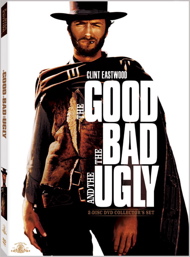
The Good, The Bad and The Ugly
1966 / , 161 min. / Il buono, il brutto, il cattivo / available separately at 26.98
Starring Clint Eastwood, Eli Wallach, Lee Van Cleef, Aldo Giuffre, Mario Brega, Luigi Pistilli
Cinematography Tonino Delli Colli
Production Design Carlo Simi
Film Editor Eugenio Alabiso, Nino Baragli
Written by Agenore Incrocci, Furio Scarpelli, Luciano Vincenzoni, Sergio Leone
Produced by Alberto Grimaldi
As stated above, The Good, The Bad and The Ugly is the same two-disc extended edition that can be read about in Savant's original review. For a splashy 2003 theatrical re-release the film was restored to most of its 1966 first-run length, re-inserting a number of Italian language scenes included only as an extra on the first 1999 disc. MGM and Alberto Grimaldi also restored a 'grotto' scene that never saw general release, but was finished and shown at the film's 1966 Rome premiere. The grotto scene became controversial mostly through the disapproval of the Leone family, as interpreted by various highly placed fans. MGM reinstated the scenes with the approval of the film's producer.
Less clear-cut is MGM's audio remix of GBU, which for the new theatrical release was expanded to fill the Dolby soundscape. Clint Eastwood and Eli Wallach returned to the recording studio to voice the new segments that had never before been dubbed into English. The loudest web objections are pointed at MGM's augmentation and replacement of key sound effects -- gunshots, cannon blasts -- to 'fill out' the new stereo track. Dissenting fans still have a reason to complain, as this new release still lacks an original (or mostly original) mono option in English. (It does have an Italian original mono track).
Sir Christopher Frayling was unavailable back when the extras for The Good, The Bad and The Ugly were created, and Richard Schickel provided a commentary instead. In 2004 Frayling recorded a full commentary for GBU with the idea that it could be added as an extra on a reissue. MGM has instead reissued the GBU discs unchanged.
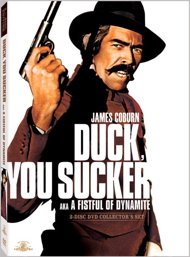
Duck You Sucker
1971 / 157 154, 138, 120 min. / Giù la testa, A Fistful of Dynamite, I; était une fois ... la révolution / available separately at 26.98
Starring James Coburn, Rod Steiger, Maria Monti, Rik Battaglia, Romolo Valli, Antoine St-John, Vivienne Chandler, David Warbeck
Cinematography Giuseppe Ruzzolini
Art Direction Andrea Crisanti
Film Editor Nino Baragli
Written by Sergio Leone, Sergio Donati, Luciano Vincenzoni
Produced by Fulvio Morsella
Duck You Sucker has been the least appreciated of Leone's films until fairly recently; this is its first appearance on DVD. Equally as slow as Once Upon a Time in The West, it represents a leap forward for the director. Leone not only tackles believable human relationships for the first time, he also has serious political ideas to communicate. It's interesting that he did not intend to direct the film or think it was a 'personal' effort, when his next signed picture thirteen years later Once Upon a Time in America continues in the same socio-political vein.
In America Duck You Sucker was chopped into bits for several reasons. Leone's previous Paramount release had been a box office failure and United Artists had no interest in another three-hour artistic western. They removed as much 'revolutionary' content as possible, trimmed some profanities here and there and then re-cut the show to speed up the slow scenes. The 160-minute picture was officially 138 for American release, but I know that in Los Angeles some prints were slashed to 120 minutes for second-runs.
The picture billboards Leone's graces and his faults. The enormous production is truly grandiose in the battle scenes, including an amazing night-for-night final battle. Thousands of costumed extras jam railroad stations. Throwaway glimpses through the windows of a railroad car reveal moving trains, mounted soldiers and hundreds of extras milling about. An awesome bridge detonation filmed in ultra slow motion sends boulder-sized rocks flying, as if a meteor had collided with the earth.
On the downside, Leone still undervalues the need for a coherent narrative. He ellipses huge sections of story while retaining extended 'atmosphere' scenes to showcase Ennio Morricone's sublime music score. As in Once Upon a Time in The West, the tale's central turning point is short-changed, giving us a Grindhouse impression of a reel gone missing. Both films play like four-hour two-parters that have been compromised. It's too bad that Leone couldn't create in the "episodic epic" form afforded Fritz Lang at Ufa, or Peter Jackson at New Line.
MGM's restored Duck You Sucker is based on Claver Salizzato's 1995 restoration of the Italian premiere version, which originally had a stereophonic track. The handsome transfer includes all known 'missing sections' of the film. A later French release excised the film's controversial final flashback entirely. It's the one scene that distinguishes this version from the 1997 MGM/Image Laserdisc that caused a great deal of excitement by upping the film's running time from 138 to 154 minutes. Salizzato's original stereo tracks could not be used because they had been mixed for the Italian language only. The 5.1 stereo heard here is another electronic reprocessing job; alternate tracks are provided in English, Spanish and French Mono. I've heard some alarms on the web that music cues in the film have been altered, but John Kirk says that he had no issues with the music and changed nothing. The web reports say that the music in the crucial 'entering the pub' flashback is different. I had no VHS source to check, but I did pull out both the 1990 and 1997 Image Laserdiscs to compare them with the new version. The music for that scene is the same on all of them. The confusion may be that the original soundtracks begin the music cue a bar or two earlier, with the series of heavier low notes.
This release also restores the film's proper title. The reissue compromise A Fistful of Dynamite has confused viewers for 35 years.
Sir Christopher Frayling really goes to town on his commentary and featurette (The Myth of Revolution), examining the film's relationship to the 1968 student rebellions and Leone's take on the then-popular revolutionary movement in European films. The film makes a strong statement against colonial oppression and Fascism but refuses to side with the Leftist, 'committed' Italian filmmakers. Leone drops his cynical detachment and instead places humanitarian sentiments ahead of Revolution, honoring family and faith as higher values. Duck You Sucker is his most mature film.
Sergio Donati speaks about his experience on the film, which seems to have been clouded by Leone's covert use of multiple writers and his terrible treatment of Eli Wallach, who was cast as Juan Miranda but kept waiting even after UA had replaced him with Rod Steiger. Restoration Italian Style features former MGM special projects director John Kirk talking about his work to reassemble the long version, and Donald Bruce's Location Comparison travels from Spain to Ireland in search of filming sites. Note that the church dynamited by John Mallory is the same building used as a hideout by El Indio in For a Few Dollars More.
The Autry Exhibit was meant as a tie-in for the world-class Leone museum show curated by Christopher Frayling and Estela Chung. The featurette saw some use on the Autry website but its 'coming soon' message is a little late, as the exhibit closed in late 2005. We do get a good look at some nice posters and memorabilia.
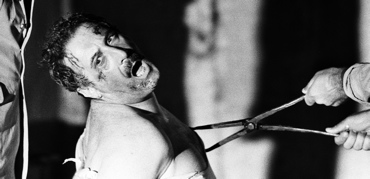
Sorting Out the Versions uses graphics, clips from old transfers and unpublished stills to illustrate various excised scenes. Savant related most of this information in a 1998 Savant article that's been updated several times over the years. Versions then proceeds to argue for a new interpretation of Duck You Sucker based on questions raised by the full-length cut: Who is the real 'Sean'? Who betrayed who back in Ireland? 1
The Sergio Leone Anthology comes in an attractive but somewhat unwieldy package. A foldout holds eight DVDs in stacks of two, which means that to find a desired disc one needs a couple of feet of clean counter space to unfurl the whole thing. A booklet contains liner notes that don't always agree with information in Christopher Frayling's extras. The disc menu design is okay, but both MGM and Fox insist on loading up the menus and featurettes with redundant logos, which become trying when watching several extras at any one time. Each title comes with a selection of trailers and radio spots.
In a few weeks Warner Home Video will release the American version of The Colossus of Rhodes, and all of director Sergio Leone's signed feature films will be available on DVD.
On a scale of Excellent, Good, Fair, and Poor,
The Sergio Leone Anthology rates:
Movies: Excellent
Video: Excellent, Fistful of Dollars: Very Good
Sound: Excellent, with reservations (see above) on The Good, The Bad and The Ugly
Packaging: Eight discs in card and plastic holder in card sleeve.
Reviewed: June 2, 2007
Footnote:
1. Savant disclaimer: I worked on the extras for all four special editions, which makes this review more informed than some but obviously not as objective. In the interest of full disclosure, and for those not familiar with my background, I worked at MGM Home Video in the 1990s and initiated studio interest in amending The Good, The Bad and The Ugly with its Italian-only scenes. I also interceded to make sure that the 30-second version of the final flashback on Duck You Sucker was not left off of the 1997 Laser release. The disc extras relied heavily on the generous help of collectors with much more knowledge of Sergio Leone, notably Bill Shaffer, Lee Broughton, Jim Wynorski, Tom Betts, Donald Bruce, Ulrich Angersbach, Ulrich P. Bruckner and Howard Fridkin. I am grateful for John Kirk's support in convincing MGM to officially change the disliked title Fistful of Dynamite back to Duck You Sucker, which once again restores the film's final 'joke'. And Gary Teetzel steered our attention to the Autry Museum's planned Leone exhibit, which helped raise awareness at MGM that these films are more than 'spaghetti westerns.'
Return
Review Staff | About DVD Talk | Newsletter Subscribe | Join DVD Talk Forum
Copyright © MH Sub I, LLC dba Internet Brands. | Privacy Policy | Terms of Use
|
| Release List | Reviews | Price Search | Shop | SUBSCRIBE | Forum | DVD Giveaways | Blu-Ray/ HD DVD | Advertise |





